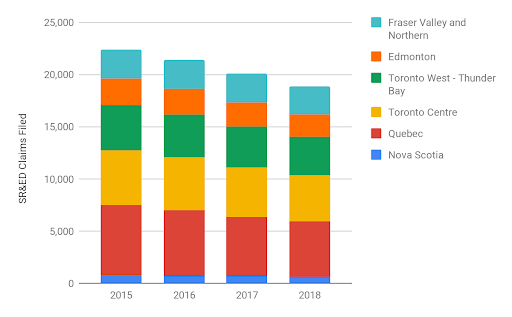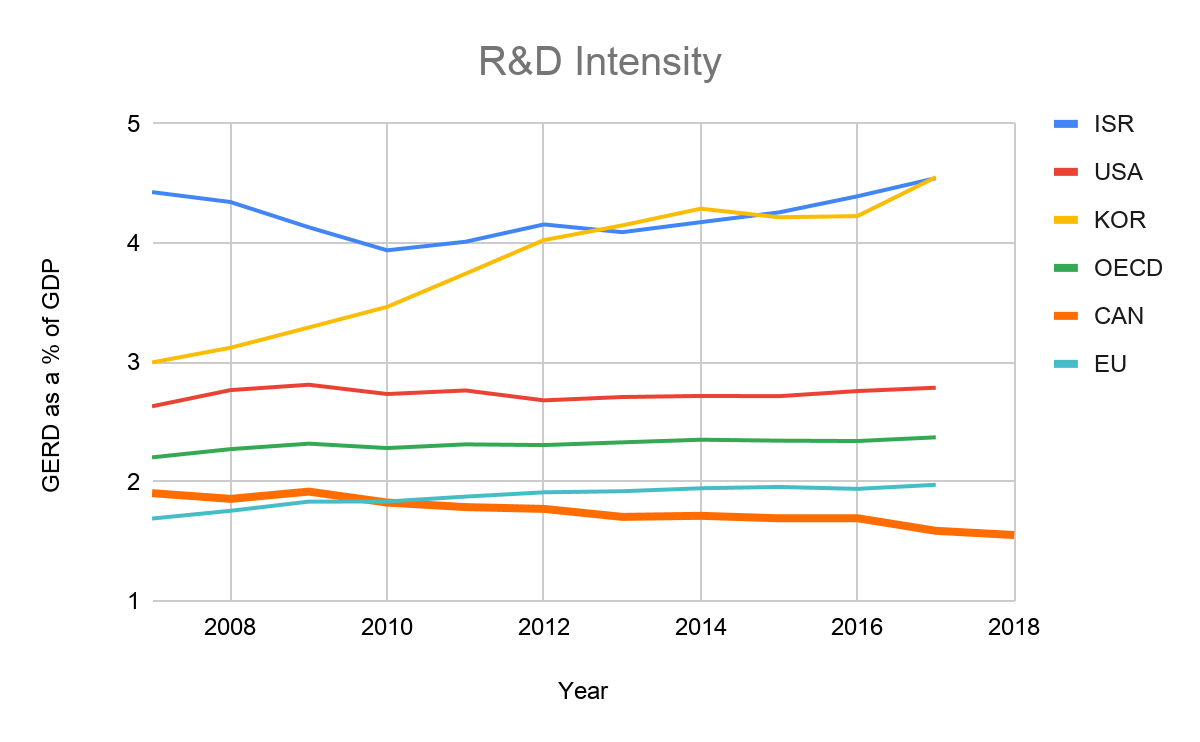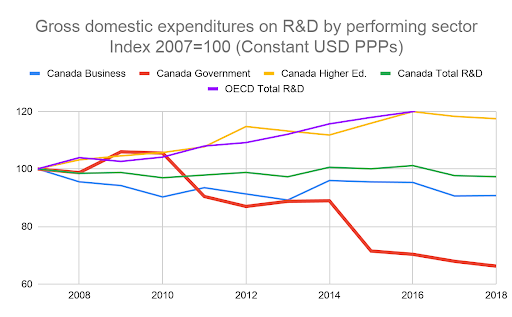Reading time: 4 minutes.
Hearing what leaders in Canada say about encouraging research and development, we should all think that Canada’s digital economy is rocketing along. Sadly, statistics on the number of SR&ED claims tell another story. The numbers show that the largest tax incentive program for R&D continues to decrease in popularity. In fact, there is evidence to show that Canada’s R&D spending is not keeping pace with the rest of the world. It would seem that the SR&ED program is not aligned with the rest of the digital economy. Let’s take a look through the lens of SR&ED claims over the past four years and see what is happening to R&D in Canada.
In 2015 there were 22,369 SR&ED claimants. The number has since fallen to 18,850 in 2018. That’s a 16% decrease which represents 3,519 claims over three years. To understand the reasons for the decrease we need to take a closer look at the details.
Leading the decline is Quebec with a 21.6% drop in claim volume. In 2014, Quebec decided not to provide provincial funding to claims under $50,000. So, it is not a big surprise that the number of claimants decreased. On the other hand, Eastern Canada experienced a 19.5% decrease while Alberta and the Prairies a 16.9% decrease. The Toronto offices saw a decrease of 15.0%. The only location where the numbers of claimants were relatively stable over the past four years is British Columbia.

In a prior article, I discussed the CRA’s review rates in different regions. With this new data, we can better understand which regions are being tough on taxpayers. In 2015, there were 22,369 SR&ED claimants of which 4,369 were selected for review by the CRA. When selected for review, 2,554, or 11.4% of total claimants received more than 50% of the ITC’s originally claimed. In 2018, 3,400 of 18,850 claims were selected for review. 1,657, or 8.8% of total claimants received more than 50% of the ITC’s originally claimed. Not only are the number of SR&ED claimants decreasing, but also those selected for a review are less likely to be successful. We can only speculate on the reasons behind this decline.
Possible reasons the decline in SR&ED Claims
- The CRA is “cleaning up” the program by eliminating taxpayers who are ineligible.
- The CRA is discouraging taxpayers from claiming by being tougher on claimants.
- The Research & Technology Advisors are not being consistent and as a result, taxpayers are shying away from claiming.
- There are fewer companies that engage in research and development in Canada.
- Companies are choosing to utilize other government funding programs such as IRAP rather than SR&ED.
- SME’s are raising so much funding through the equity market that the effort to apply for SR&ED is no longer cost-effective.
How does R&D in Canada compare to other countries?
If we look at Canada on a global stage, the Organisation for Economic Co-operation and Development (OECD) provides telling data. The chart below shows that R&D intensity (expenditure on R&D as a percentage of Gross Domestic Product (GDP)) in the OECD countries rose slightly from 2.35% in 2014 to 2.37% in 2017. This was largely driven by growth in the United States, Japan, Germany and Korea, offsetting a decline in Canada and several other European economies. Canada fell from 1.71% to 1.59% in 2017 and to 1.55% in 2018. In 2017, South Korea and Israel continued to be the countries with the highest R&D intensity, at 4.55% and 4.54% of GDP, respectively while the USA was 2.79%.
It seems Canada is investing less in R&D than in the past as we continue to fall further and further behind our OECD peers.

The Canadian government has been consistently decreasing spend on R&D
The chart below clearly shows the bulk of the decline in Canada’s investment in R&D over the past 5 years comes from the decrease in government spending. To be fair, governments overall have decreased their spending, but the total spend in R&D has increased from a baseline of 100 in 2007 to 124.8 in 2017 for all OECD countries while in Canada it has decreased from 100 in 2007 to 97.3 in 2018.

Let’s look at where we are today. CB Insights lists 403 unicorn companies (private companies with over $1B valuation) of which 1 (yes ONE) is Canadian. This compares to 196 from the US. Israel, with a ¼ of Canada’s population, has 8 on the list. The question to ask is how can the Canadian Government help build and retain great Canadian technology companies?
Unless Canada starts to invest more in R&D and the government provides more support, Canada will be shut out of the knowledge-based economy. Canada will have satellite offices to accommodate the immigration policies of other countries but the true economic engine of having great Canadian-headquartered technology companies will not happen.
While the Business Development Bank of Canada (BDC) loan portfolio has grown by 41% from 2015 to 2019 and the IRAP program has also received additional funding, Canada’s global competitiveness in research and development is falling behind its peers.
Let’s make the SRE&D program more predictable and widespread. Let’s not have government organizations attempt to pick which companies to fund. The SR&ED program should be double the size and funds allocated for BDC and IRAP should fund private lending and venture capital. We just have to look south of the border to the US Department of the Treasury’s Small Business Lending Fund where the government provides low-interest loans to banks and alternative lenders. This funding allows experts, who have skin in the game, to decide who to invest in. Providing additional government stimulation via the private sector will give Canada the foundation to be globally competitive in the Information Age.
About Garron Helman
Garron helps company founders grow their businesses by providing non-dilutive financing to hundreds of great Canadian startups. Garron is a recognized leader in SR&ED identification with expert knowledge in tax credit programs in Canada.
Contact Garron to learn more about the SR&ED program and how venture debt can help accelerate your business’s growth.




